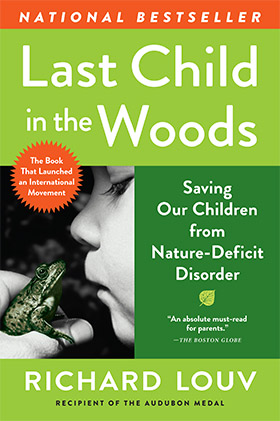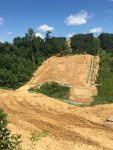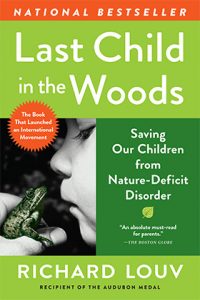- Like
- Digg
- Del
- Tumblr
- VKontakte
- Buffer
- Love This
- Odnoklassniki
- Meneame
- Blogger
- Amazon
- Yahoo Mail
- Gmail
- AOL
- Newsvine
- HackerNews
- Evernote
- MySpace
- Mail.ru
- Viadeo
- Line
- Comments
- Yummly
- SMS
- Viber
- Telegram
- Subscribe
- Skype
- Facebook Messenger
- Kakao
- LiveJournal
- Yammer
- Edgar
- Fintel
- Mix
- Instapaper
- Copy Link
A review of Last Child in the Woods, by Richard Louv:
Some (ok, many) years ago when I was a sixth grade teacher, on occasion I would take my class outdoors to sit under a wide tree about a hundred yards from the school building. Each student carried a chair to sit on, and a book, and we had a few lessons that way during nice weather. The school principal thought I was crazy, but he let me continue.
After reading Louv`s chamade to the joys of the varied environments we experience on earth, I rue the many lessons that went untaught: I never imagined I could go further, that science and nature was all around us under that tree while we read from a book and not from a blade of grass, a leaf, a bug!
That said, after reading Louv’s exciting, and inciting, book, I would not make the same mistake again. Perhaps, the reader will not, either.
And, that is what The Last Child in the Woods is about: correcting the errors we make by not involving children (and ourselves) more in the magnificent swirl of natural things.
Eleven years ago, when the book was published, the research cited by Louv on the stultifying
effect of the lack of living, learning and playing in natural surroundings was not as extensive as
it is now…although I daresay it was as conclusive: as we lose contact with nature, we lose
contact with ourselves. Natural play, the making of dams in streams and climbing trees and
building forts are all increasingly subject to litigation, brought on by laws regarding liability, and
community rules disallowing nature to be spoiled by these childhood activities. What happens if
a child breaks a leg falling from a neighbor’s tree or skins a shin from a fall down a pebbly path
in a park? Do you think of a lawyer…or a first aid kit? Both? And, what about the unexpected
and dangerous stranger lurking in wild places? Personal safety training is important, but a child
is less likely to be victimized when a good relationship with a parent is evidenced and the child
has a strong sense of self and confidence. This happens when the child and adult do things
together, things like walking in the woods, and looking at the dark.
Yes, there is a lot to think about in modern America. Why are we afraid to let children be
themselves in the outdoors? Why are we afraid to be ourselves in the outdoors? And, most
important–for those of us at a certain age–why have we forgotten what we were as children in
the outdoors? Were we joyful, free, curious explorers of the wild unknown in the vast world of
our backyards? Alas, are we plugged-in too much even to care? No wonder our health suffers;
we do not sleep well; we do not reflect on anything for more than a few seconds at a time, our
communications seem to be short on depth. We tweet a few characters, and good night.
Louv chocks his insightful book with remedies from the possible, imaginative, and, fortunately, to
things happening to help us overcome the gaps in American life between nature and humans.
For example, the Outward Bound program, a success for many years, has provided personal
growth experiences through adventure-education programs for over 500,000 students in primary
and secondary schools. As another example of very many, he considers the Urban Corps, which
gives young urban Latino males time to experience the 2,600 acre Crestridge Ecological
Reserve in California, where they engage in conservation work and learn about native species
of fauna like the dusky-footed wood rat and its blood-sucking hitch-hiker, the ‘kissing’ or
assassin bug.
It is not only in America that these programs exist. Louv cites community development programs
in the Netherlands, where a project called ‘Het Groene Dak’ (The Green Roof), has a wild inner
garden where cars are banned and children are free to play, residents to socialize. He considers
similar programs in Sweden, and British Columbia, as well.
Adults, of course, are teachers whether they accept this role or not, and Louv cites several as
examples of how their love of nature was transmitted to others. He mentions OVEC’s Janet
Fout (now Keating and now retired) several times, and how she loved playing in knee-deep water near her house after a rain, and how she taught her daughter the reverence for nature which she carries in her dense urban life in Washington, D.C. (D.C., I read recently, is presently developing a National China Garden: nature continues to nurture in the midst of our nation’s capital!)
On the other side of the country, some want to envision San Diego, California, as the nation’s
first ‘zoopolis,’ or, as Chicago’s 165 year-old motto proclaims, a ‘City in a Garden,’ where
development would conform to topography (no blazing and razing), places would be used for
what they are naturally most fit, all natural resources would be conserved, developed, and
utilized, and beauty would be secured through organic means rather than by superficial
adornment. In a zoopolis, schools would use natural environments as classrooms (the tree my
class sat under could have been the subject of an entire curriculum!).
The book ends with a chapter on nature and (mostly Christian) spirituality, where Louv sees
Genesis as bringing people closer to a creator, where children experience nature, not because it
may be pretty (much is not), but because it is developmentally important to be exposed to
something larger than ourselves, and longer lasting than immediate human existence.
Throughout this information-packed book, Louv mentions many organizations sensitive to the
idea that the natural environment must be integrated into our daily lives. I would have
appreciated a listing of these organizations and groups if they had been appended.
Although Louv considers the impact that human populations are having on the constriction of
nature and natural resources, population control does not seem to be among Louv’s prime foci.
A serious discussion of population control is as difficult a topic as any raised–in any book: it is
the elephant in the rooms of every book on the environment. Perhaps, it was omitted because
the effects of an increasing population have been discussed elsewhere. However, as these
discussions to date have not led to a decrease in the numbers of humans on our fragile planet,
why not add to the discussion here?
I like the enthusiasm with which Louv writes, and would recommend this book to anyone
interested in learning how the environment can beneficially impact the lives of children and
adults. Surely, I would welcome an updated version, to learn what programs have succeeded
and failed, and what new innovations have come along since 2005 to keep our children in the
woods, not last, and certainly not least.
Frank E. Grant, Ph.D., is a sustaining OVEC member. His opinions here do not necessarily reflect any official OVEC view or policy.
Frank will be reviewing books that in some manner include a mention of OVEC’s work, volunteers and/or staff.














